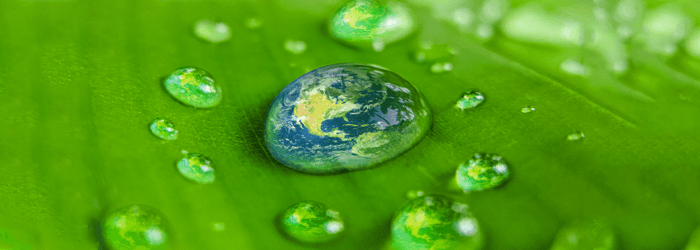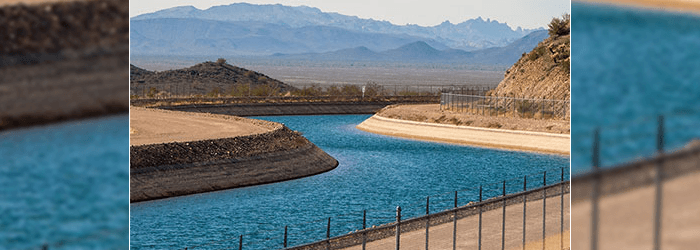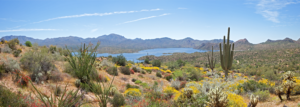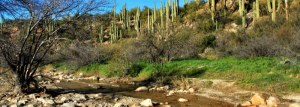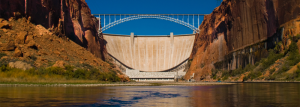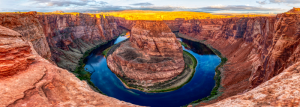We consistently hear that Arizona is running out of water…but are we just not looking in the right place?
If you are a regular listener of the Rosie on the House broadcast, you know that water is a topic of particular interest to all of us, for obvious reasons. We do a lot of research, attend conferences, follow water-related legislation, interview water specialist and subscribe to every water-related publication we can find…but none of them are talking about Primary Water. In fact when we have the opportunity to directly ask experts about it, the response is pretty uniform: “I’ve never heard of it.”
What is Primary Water?
Primary water is created by earth’s energy, meaning water regenerative and unlimited.
Too good to be true, right? That’s what we thought when we first hear about Primary Water on a Kate Dalley radio broadcast stating “there is no shortage of water, learn for yourself at the Primary Water Institute“…and that’s how we entered this rabbit hole.
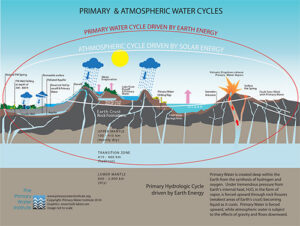
Simply put, water vapor is formed in earth’s core and seeps through the mantel to the surface by the heat produced from magma. As the vapor makes its way through cracks and faults in the crust and away from the magma, it cools and turns into its liquid form.
This completely shatters the narrative that earth is limited to the atmospheric cycle of water (evaporation, condensation, runoff, repeat) that limits us to water that is already on the surface and in the atmosphere. Instead, water has no end to it’s supply as it’s continuously creating and adding to our atmospheric water. Exactly how much water are we talking? The estimates we have seen indicate two to three times the volume of water than what is currently in all earth’s oceans. This the infographic from the Primary Water Institute provides a simple illustration of how it works.
The concept is very easy to comprehend. Why it is not circulated in mainstream information is perplexing. Is it really too good to be true people just don’t believe it? If that is where your train of thought has you at this moment, let’s take some time to look at evidence for Primary Water.
NOTE: If you have already connected the dots, you can skip down to Practical Application for Primary Water.
Evidence for Primary Water
We will start with a very detailed explanation of earth-generated water in this article by Scientific American identifying a mineral named ringwoodite that was discovered in Brazil after it made its way to the earth surface through volcanic eruption. The article states this is “actually the confirmation that there is a very, very large amount of water that’s trapped in a really distinct layer in the deep Earth.”
It’s also important to note the supporting evidence that volcanic ash itself is 85% water vapor at the point of eruption. Now, not many of us will ever be in a position to personally examine the ringwoodite or understand what we were looking at if we did, so let’s look at a few examples right here in Arizona where we can see proof of Primary Water via natural springs.
Unlike ground water wells that have been mechanically pumping for hundreds of years with windmills to electric pumps sucking water to the surface, Primary Water is naturally pressurized to the surface. Near Kohl’s Ranch just below the Mogollon Rim, lays Horton Springs, a popular hiking destination that is a perfect example of Primary Water. Hikers can visit the spring year-round, 24/7 and refill their drinking containers with pure, cool, and fresh (new) water. We have all witnessed the nature of water seeking its own lever as it flows downhill in a stream and spreads out in flat areas creating a pool. The pool continues to fill until enough volume of water is collected, it raises over the barrier spilling over the top, and repeats this cycle until reaching the ocean, as long at the water source continues to flow.
Have you ever seen a stream flow uphill? So how can a continuous, consistent amount of water pour out of a mountain thousands of feet above sea level with no mechanical pump to draw the water up? Primary Water explains earth magma is pushing water vapor to the surface and turns it into liquid form as it cools reaching the surface. This means there is a crack in the earth’s crust leading to the point of discharge at the spring. Makes perfect sense, right? How else could it work? After all, heating water into steam that rises, is the pressure which spins the turbines in our coal and nuclear plants, powering our electric grid. Is it so hard to believe liquid hot magma couldn’t do the same?
Primary Water is also found at Castle Hot Springs north of Lake Pleasant in the Castle Creek tributary. The water here is much hotter than the water at Horton Springs indicating the vein of magma is closer to the surface at this location. Many Colorado River rafters stop at Pumpkin Spring in the Grand Canyon to take pictures of the orange water flowing up from the core. The founder of Primary Water Institute, Dr. Stephan Riess, explains in this interview at the 37:37-minute mark, that every degree of water temperature below 1,600 feet is equivalent to 80 feet of depth into the core.
Primary Water sources are not limited to dry land penetrations. Sub-surface penetrations below fresh and sea water have been well documented. This also means Primary Water is as old as Earth’s creation and there are many documented historical cases of humans using of Primary Water. Many of the Roman aqueducts were sourced from natural springs. According to Dr. Riess, early documentation describes Primary Well digging under Charlemagne and castles like the Edinburgh Castle in Scotland were built around Primary Water wells covered at the 57:32-minute mark in Dr. Riess’ interview.
If you have an inquiring mind and can set aside the time to focus, the following two video interviews are the most complete and comprehensive interviews we have found to date.
What is Primary Water? 1985 Interview with Dr. Stephan Riess
Debora Tavares interview’s Dr. Stephan’s protege Pal Pauer.
Practical Application for Primary Water
Let’s start with the delivery of water.
Forget pipelines from halfway across the country, it’s expensive to pump large volumes of water. Just ask CAP who is the largest energy consumer in Arizona and their canal is only 336 miles long. To pipe from the Mississippi or Snake Rivers would require more than double that distance…and what do we need to generate electricity? That’s right, more water! Forget pipelines. Forget desalinization. Use gravity, it costs nothing.
PrimaryWater.org reports that “in the 1960’s, the late Dr. Stephen Riess…proposed a water delivery plan which included drilling 8,000 Primary Water wells in the mountains above the cities that gravity would deliver down hill eventually flowing into tributaries that flow into our water management infrastructure. With a conservative average of 270 gallons per minute, per well, it would be producing more than 3,100,000,000 gallons of water per day (8,000 x 270 x 60 x 24), 365 days a year.”
To put that in perspective:
- 1-acre foot of water is 325,851 gallons.
- 3.1 trillion gallons divided by 325,851 = 9,513.55-acre feet of water…PER DAY!
- Before low water levels at Lake Mead forced Colorado River pumping reductions, CAP was allocated 1.4-million-acre feet of water per year. Divided by 365 (days) = 3,835.61-acre feet per day.
Dr. Riess’ proposal would generate 2.4 times CAP’s Colorado River allocation, without the ongoing demand of the electrical grid.
Because Arizona has done such a great job engineering its water infrastructure, everything is already in place to receive this additional water.
Primary Water wells drilled along tributaries that feed into Arizona’s natural watershed would simply add an additional source of water beyond rain and snow to keep our reservoirs at full capacity while still making 100% of existing water deliveries.
Additional benefits include the potential to offer flexibility of water exchange contracts. One such example could be a Buckeye and Yuma exchange. Currently CAP – Central Arizona Project delivers Colorado River Water to Buckeye where a substantial amount of alfalfa (among other agricultural commodities) is grown to feed our dairy and livestock industries. If Colorado River rationing continues while Primary Water pours into the Verde River (which is a perennial river in Arizona indicating it as a source of Primary Water) and Salt Rivers, SRP – Salt River Project, who manages the water flow and reservoirs on these river sheds, could then provide Buckeye with the surplus of Primary Water. Buckeye could then allow their CAP water allocation to flow past the Mark Wilmer pumping station in Parker and instead be pumped out in our Yuma agriculture fields. Yuma could then:
- Offer Buckeye priority for agricultural commodities
- Charge their groundwater basin
- Store the unused water in Lake Mead, helping it refill
- Exchange/sell seasonal excess water to Mexico
These examples are hypothetical, and we have no idea if any of the mentioned parties would be interested in such negotiations. A seasoned farmer could probably rattle off two-dozen better examples without having to think about it. These ideas are examples of how an influx of new water could curb the “who gets what” argument as water restrictions are implemented and would instead provide the flexibility of readily available water and allow restoration of dwindling reservoir levels. The possibilities don’t stop there.
If the volume of Primary Water projected by Dr. Reiss in the 1960’s was achieved in Arizona alone – on top of all the benefits listed above and instead of furloughing farm land (like many uninformed advocate for, without an affordable or realistic alternative solution to supplement our local food supply) – we could supply farms with access to Primary Water and furlough agriculture ground wells, thus allowing our underground aquifers to refill with the natural atmospheric water cycle, as illustrated above. Perhaps this would allow Arizona to reverse its diminishing farms lands, as a result of water tier rationing on the Colorado River and residential/commercial/industrial developing over agriculture fields, to possibly expand our farming and ranching industry — just like most other industries in Arizona are doing. If Arizona could make this a reality, we could benefit all the states in the Southwest. Together we could refill and keep all seven reservoirs along the Colorado River full regardless of rain/snow runoff. If the Southwest did this locally, imagine what we could do globally!
It could NEVER happen.
Skeptics who have read this far are probably asking “what happens when we run out of Primary Water like we are running out of Colorado River water?”
Easy question to ask because it’s hard to comprehend the volume of water we are talking about. USGS reports that three percent of Earth’s water is freshwater. Of that 68% is frozen in glaciers. That means, globally we are using less than 1.3% percent of the available fresh water to supply eight billion people. The Southwestern states, specifically those in the Colorado River Compact — Upper: Wyoming (576K), Utah (3.27M), Colorado (5.77M), New Mexico (2.11M) – Lower: Arizona (7.15M), Nevada (3.1M) & California (39.53M) contain 61.5 Million people. Divide that by eight billion people worldwide. That leaves .007% of the earth’s population residing in the United States Southwest region.
When you start to calculate ratios of the estimates, there are two to three times the volume of Primary Water below the crust than what is currently in all of Earth’s oceans (keeping in mind Earth is constantly creating and releasing new water), against the percent of atmosphere freshwater we use, you will realize we are talking raindrops to the ocean — an argument that is swept away like a stupid motorist in Arizona Monsoon flash flood… water pun intended!
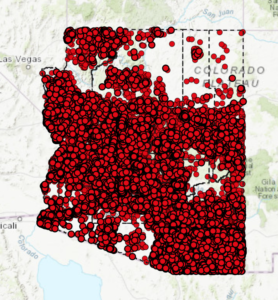 Skeptic: “But Dr. Riess’s proposal was for 8,000 wells; we couldn’t drill that many in Arizona.”
Skeptic: “But Dr. Riess’s proposal was for 8,000 wells; we couldn’t drill that many in Arizona.”
Fact: Arizona already has more than 8,000 ground water wells drilled. If you have time to count the red dots on this map, to get an exact count, you can let us know the exact number. Remember, Primary Water is NOT the same as groundwater so this does not put a strain on our underground aquifers. It’s a different source of water and will help refill ground water by reducing the need to pump from the groundwater aquifers.
How do we get started?
This has never been done, but there is a similar industry that could be modeled to get the ball rolling, or the water flowing, so to speak — oil drilling.
Step #1: Build Arizona’s Water A-Team similar to a typical oil drilling team consisting of:
- Geologist(s) to study Arizona Geological Survey’s (now located at the University of Arizona) records of 100 plus years of earthquakes, faults, and fissure maps to identify potential drilling locations.
- Property owner research(ers) to obtain proper approval to drill on land identified as a Primary Water drilling site.
- Road construction crew(s) to get locations mentioned on previous line, when need be.
- Primary Well drilling team(s) and equipment.
Step #2: Here is where is gets tricky and the whole process will slow to a crawl:
- Get local and potential national lawmakers and attorneys involved. Arizona water law clearly defines who owns the ground water from individual private wells all the way to the Phelps Dodge mining company holdings. The first order of law will be distinguishing the legal definition between Primary Water and Groundwater, so landowners understand Primary Wells drilled on their land is not drawing water out of their aquifer. This is new water to the atmosphere.
- A fair market monetary value of Primary Water produced in gallon per hour, or by barrels to follow the oil industry, will need to be established. This will allow an account to be set a private utility company similar to APS, called “Primary Water for Arizona” (PWA) who would set the rate governed, reviewed, and approved by the Arizona Corporation Commission. Monetary value would allow Primary Water providers to charge water districts a fair market value on the Primary Water they are delivered. These funds would then supply the monetary side of contracts and leases with landowners to drill, along with access easements, investing in additional Primary Well drilling and maintaining the operation and control of water flow, and security of Primary Wells drilled.
Simply said and complicated to execute. But where there is a will, there is a way! Currently, we have a unique timing opportunity to get this established based on the critical criteria that 1. The Southwest is in a drought, and we need real-time solutions, not 30-years constructing a pipeline stretching 1,000 plus miles and 2. With AZSB1740 dedicating $700 million to securing new water resources between 2023 – 2026, a grant from that fund to establish the first six Primary Wells would set the wheels in motion for this to turn into a self-funded solution. All we need is bipartisan legislators who can act quickly or a $250 million private investor…that’s not too much to ask, right?
Learn about Primary Water and speed the word. The answer to water is as old as time. We just need to use it properly.
###

